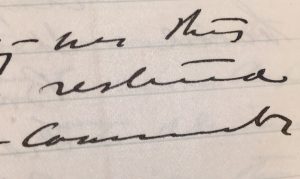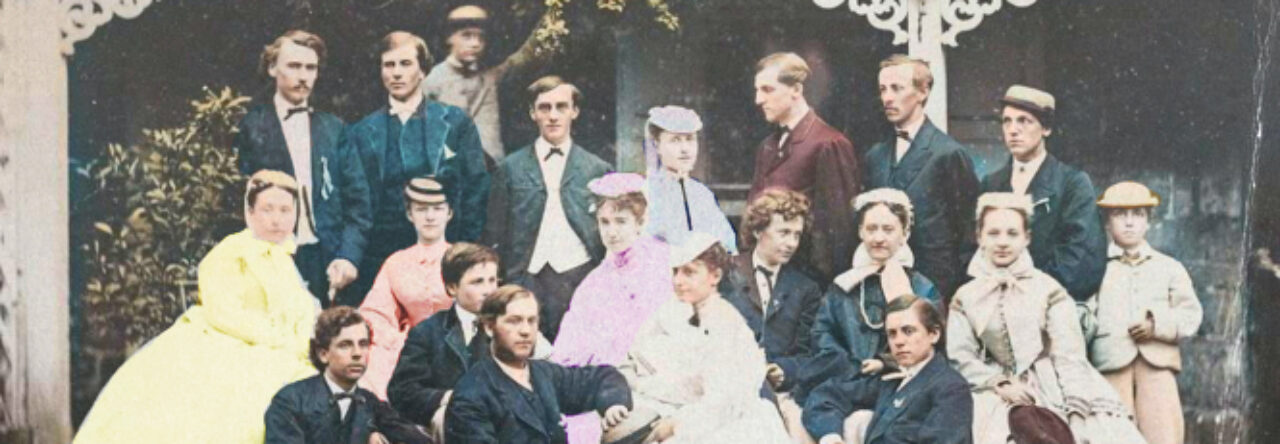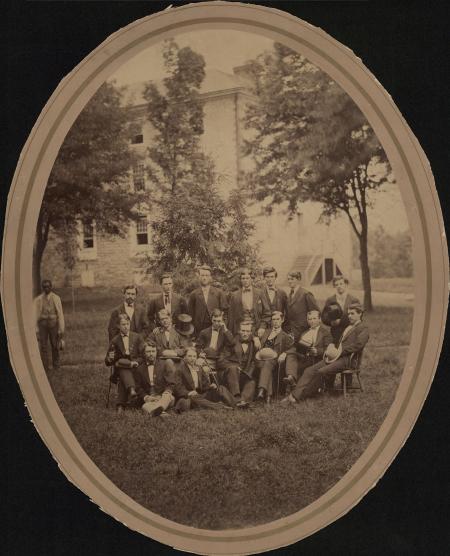When I was initially assigned the class of 1870 I must admit I was a little disappointed. As someone with a keen interest in military history, I was hoping to get one of the Civil War-era classes, as the events of the war would have been pertinent to its members at the time, but sadly this was not the case. Nevertheless, I looked through the 1870 class roster, did some quick searches of a couple individuals on the college archive’s online database and went in to take a look at some documents a day or so later.
Having done some archival research on Dickinsonians my previous year, my first instinct was to check for a class of 1870 yearbook. Fortunately, I was extremely lucky; although the college didn’t start printing the Microcosom (the name of Dickinson’s yearbook) until 1890, the class of 1870 had created one after the fact in 1903.
I began by investigating the senior information pages. Initially, I had the idea that I would focus my project around the railroad boom during this period, as I knew that the intercontinental railway had been completed in 1869. I found several individuals who went on to work for railroad companies or in other railroad-related financial ventures, as well as a few others who caught my eye; namely Edward R. Johnstone, a reporter on the Indian Wars, and Philip Rawlings, an ex-Confederate who served under General Jackson.
After scanning through the senior profiles, I next made my way to the class history section, which was written by several members of the 1870 class. While reading and taking notes, I came across one short paragraph in particular that grabbed my attention. In it, the author briefly mentioned the “‘Great Rebellion’ of the Sophomore and Junior classes” in 1870.[1] Incredibly intrigued by the idea of a student rebellion on campus, I immediately decided to take a look into it.
Frustratingly, the class history provided no more information than the classes that participated in the rebellion and the year it took place, the latter of which had to be discovered through the document indirectly. I then approached the archivists in order to figure out where I could find more information. I was directed to the published history of the college, as well as the president’s papers and minutes from both trustee and faculty meetings. It was here that I discovered a much more comprehensive overview of the event.
The student rebellion of 1870 (there have actually been several over the course of the school’s history) was in response to faculty not allowing Sophomore and Junior students to attend the celebrations in Carlisle on April 26th, 1870 over the ratification of the 15th Amendment. In defiance of their professors, the students went anyway and received “500 minus marks” as punishment. This appears to have been rather harsh, because it caused an uproar among the two classes of effected students. The faculty attempted to rectify this by adjusting the number of “minus marks” given on a case-by-case basis, but to the students it appeared to be done at random and simply made the situation worse. The sophomores and juniors then decided to boycott their duties (classes, etc.) and, as punishment, the entirety of both classes were suspended indefinitely and made to return home. After much back and forth, the suspension was lifted on May 16th after an appeal from the student committee.[2] Below is my transcription of the appeal, which was found handwritten in the faculty minute book dated 1869-1879:
To the faculty of Dickinson College May 16, 1870
Gentlemen,
Whereas it is evident for that there have been misunderstandings of communications made by the faculty to the students, and whereas we have shown as we think a proper spirit since our suspension; and whereas we are satisfied that in the matter of minus marks the faculty will, on a proper and [illegible] consideration of our complaint, do us justice.
We respectfully request that you will repeal the penalty of suspension now in force against us in order that we may resume our relations with the College, and attend our duties as usual.
J. L. Shelley
J. H. Shopp
D. K. Watson
D. J. Mayors Jr.
Members of Council
Fortunately, a transcription from the minute book, as well as a printed copy of this message, can both be found in the archives. The correct transcription is below:
May 16, 1870
To the Faculty of Dickinson College, Gentlemen:
Whereas it is evident to us that there have been misunderstandings of communications made by the Faculty to the Students; and whereas, we have shown as we think a proper spirit since our suspension; and whereas, we are satisfied that in the matter of minus marks the Faculty will, on a proper and full considerations of out complaint, do us justice.
We respectfully request that you will repeal the penalty of suspension now in force against us, in order that we may resume our relations with the College and attend to our duties as usual
(Signed)
J.L. Shelly
J.H. Shopp
D.K. Watson
D.J. Myers, Jr.
Members of Committee

A Particularly Painful Example of 19th Century Penmanship, Courtesy of the Dickinson College Archives and Special Collections
As one can see by the several errors in my transcription, interpreting handwriting from the 19th century is often no easy task. That short section alone took me around half an hour, and further transcription of more notes from the same meeting proved to take even longer. Minutes are especially difficult, as the writer is generally trying to keep pace with the discussion, leading to ample use of abbreviations and poor penmanship overall. The photo on the right shows one particularly bad example from the minutes, and is supposedly meant to say “commencement”.
Getting back to my research, there was some other information in the Dickinson history book that also caught my attention. Firstly, it mentioned a mixed reception of the 15th Amendment within Carlisle. Although there was celebration, the book stated that several newspapers referred to it as the “darky amendment”. Also, there was mention of signs being waved about the persecution of Dr. McClintock, whose name is on one of the college’s dorms. A quick search on the House Divide Project website led me to a PDF that explained the story of Dr. McClintock and a riot that occurred in Carlisle in 1849 partially on his behalf. I also found mention in the 1870 yearbook history that two students, the Mercier brothers, joined the KKK in Virginia.
Although I had made progress, I was left with several major questions: Were the statements about the Mercier brothers true and, if so, how did they interact with both other students and faculty on campus? How was Dr. McClintock “persecuted” and why did it cause rioting? How was the 15th Amendment received in Carlisle? Were there any serious debates on campus regarding the 15th Amendment, especially considering the Confederate/Southern background of several of the students in the class?
Ultimately, after my first round of research I’ve been left with more questions than answers; however, I am confident that many of these riddles will be solved in upcoming trips to the archives and other locations, such as the Cumberland Valley Historical Society. Most importantly for this early round of research, however, I have nailed down a topic: the 1870 Student Rebellion and the mixed reception of the 15th Amendment in Carlisle, PA.
[1] Class of 1870, The Dickinson Class of 1870, 1903, Archives and Special Collections, Dickinson College, Carlisle, PA, pp. 113.
[2] Dickinson College Faculty, Sophomore & Junior Suspension Appeal Petition and Remission of Suspension, 1870, RG 2/7, President’s Papers 1.1.2, Archives and Special Collections, Dickinson College, Carlisle, PA.


Leave a Reply